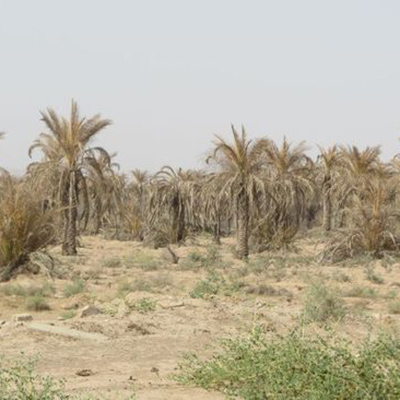Sites
Dasht-e Abbas
Maryam Bayatlouei
Translate by: Hadi Qorbanyar
86 Views
Dasht-e Abbas was one of the main bases of the northern axis in Operation Fath al-Mubin. In terms of administrative divisions, Dasht-e Abbas is part of the Musian district in Dehloran County, Ilam Province. Located at the border of Ilam and Khuzestan provinces, it is the gateway to Khuzestan.[1]
A mausoleum located eleven kilometers from Dasht-e Abbas serves as a defining landmark, giving the region a special cultural and historical identity. The shrine is attributed to Abbas ibn Fazl ibn Hassan ibn Ubaidullah ibn Abbas ibn Ali ibn Abi Talib (as), and Dasht-e Abbas owes its name to this distinguished personality. The Imamzadeh Abbas is located at the center of the plain, and the lands extending for kilometers beyond the mausoleum are also considered part of Dasht-e Abbas.
The Andimeshk-Dehloran Road, which runs through the heart of Dasht-e Abbas, is one of the five important and vital roads in Khuzestan, serving as the main route for the movement of the Dezful Islamic Revolutionary Guard Corps (IRGC) forces to control the borders and counter the Arab Peoples Movement in Khuzestan.[2]
Dasht-e Abbas is bordered to the north by the southern slopes of Kabirkuh, to the east by the Dehliz and Ali-Gerehzad heights, to the south by the Tineh Heights, and to the west by another part of the Tineh Heights as well as the Ain-Khosh area.[3]
Dasht-e Abbas has a hot and dry climate in the summer, accompanied by dusty winds that usually blow from west to east, while in winter, the weather is mild, clear, and calm. Unlike the surrounding areas, which are mostly mountainous and hilly, the terrain of Dasht-e Abbas is soft and suitable for agriculture. Due to its vegetation cover and fertile soil, the region also serves as a winter camp for nomadic tribes who migrate to Dasht-e Abbas from northern areas during the cold season. The relatively flat and unobstructed terrain of the plain provides good maneuverability for armored units.[4]
Moreover, by controlling the northern, eastern, and western heights of Dasht-e Abbas, the entire western region of Dezful can be monitored. The northern heights of Dasht-e Abbas (Kabirkuh Heights) also serve as effective barriers against enemy advances.[5]
With the onset of the Iran-Iraq War, six divisions of the Baathist regime were assigned to attack Khuzestan.[6] One of the main objectives of the Iraqi army to gain complete control over Khuzestan was to capture the vast and extensive area west of the Karkheh River in the Shush and Dezful regions.[7]
Given the expansive terrain and the complexity of the objectives, enemy forces in this area operated on two axes: Fakeh-Shush and Sharhani-Naderi Bridge. After crossing the border posts, they advanced deep into Iranian territory. In the Sharhani region, Iraq’s 10th Armored Division crossed the Doviraj River, captured Ain-Khosh, and then advanced through Dasht-e Abbas towards the Karkheh River and Naderi Bridge.[8]
With the fall of the region’s border posts, the Ain-Khosh military base was occupied by the enemy. The invading forces then moved towards Imamzadeh Abbas and Dasht-e Abbas, and from September 27, 1980, Dasht-e Abbas was completely occupied by Iraqi forces, becoming a stronghold for the 42nd Armored Brigade.[9]
On November 4, 1981, the Army commanders held a meeting at the 21st Division Headquarters (Sabzab, Dezful), which led to the establishment of a tactical headquarters in the Dasht-e Abbas and Ain-Khosh regions. This marked the beginning of the formation of the Quds Headquarters.[10]
The Quds Headquarters was responsible for liberating Dasht-e Abbas. In fact, the headquarters had two major operational objectives: liberating the areas of Ain-Khosh, Dasht-e Abbas, Hill 202, and cutting off the strategic Abu Ghraib Road from one direction, while preventing the enemy from entering the Dasht-e Abbas via the southeast in another direction.[11]
On November 9, 1981, a meeting was held at the forward headquarters of the Iranian Army Ground Force, where it was announced that the series of operations to liberate Khuzestan would be named Karbala. Operation Karbala 2, carried out on November 10, 1981, was named Fath al-Mubin.[12] With the announcement of the initial plan for Operation Karbala 2 (Fath al-Mubin) on February 3, 1982, the 2nd Armored Brigade of Dezful, known as the Mazasvar Brigade, prepared to move over 300 kilometers to the north of Dasht-e Abbas, to an area called Lazeh that had been previously scouted.[13]
In Fath al-Mubin, which was a turning point in the history of the Sacred Defense, the areas of Dasht-e Abbas, the Dehloran-Dasht-e Abbas Road, the Ain-Khosh Heights, and Barqazeh were liberated, and Shush, Dezful, and Andimeshk were removed from the range of enemy artillery.[14]
In early 1982, various bases under the command of the IRGC began operating in Dasht-e Abbas, Dehliz, Balata, and other locations to counter enemy forces. The commander of the Dasht-e Abbas axis was Abdullah Ahmadi. Perhaps the most important mission of this base was the precise identification of enemy positions and movements in an area covering the west of the Balata Hills to near Ain-Khosh. Detailed and accurate reconnaissance was crucial—not only because Dasht-e Abbas was meant to serve as the junction point for the Quds and Nasr headquarters, but also because its flat, open terrain made it perfect for tank and armored vehicle movements.
The most significant operations conducted in the Dasht-e Abbas include Operation Muharram, carried out from November 1 to 11, 1982, in the southern frontline of Ain-Khosh-Zubeidat, to capture a bridgehead in the Al-Amarah region and liberate border heights, resulting in the liberation of 500 square kilometers of occupied territory; Operation Preliminary Valfajr, conducted from February 6 to 10, 1983, in the southern and northern parts of Chazabeh, aimed at advancing towards Al-Amarah, ending without success; and Operation Valfajr 1, carried out from April 10 to 17, 1983, in the southern frontline of Jabal Nuqi, aimed at advancing towards Al-Amarah, during which Iranians could break the enemy’s defensive lines but failed to secure the liberated area as they left without the support needed.
In addition to the Dezful IRGC forces, a special group led by Major General Martyr Hassan Abshenasan was deployed to Dasht-e Abbas to conduct guerrilla operations. Also, after the enemy had established its position west of the Karkheh River, the 84th Infantry Brigade of Khorramabad was deployed in the northern heights of the Dasht-e Abbas and Ain-Khosh.
One of the tactics frequently used by reconnaissance forces in Dasht-e Abbas was eavesdropping, carried out with the help of local Arabs.[15] However, Martyr Tavakkol Qalavand stood out as one of the key figures in the Dezful IRGC, known for his skill in reconnaissance and field operations. Raised in the mountains, Qalavand had the skills and instincts needed to move easily through difficult terrain. He often worked at night, taking a camera and necessary equipment, penetrating deep into enemy lines, and gathering critical information about the number of troops, military equipment, and their deployment locations. For this reason, he became known as the “AWACS of Dasht-e Abbas”.[16]
On Saturday, March 27, 1982, the Nasr Headquarters, commanded by Hassan Baqeri, the Quds Operational Headquarters, the 14th Imam Hussain (as) Brigade, the 84th Khorramabad Brigade of the Army, as well as the Abuzar Ghaffari, Moslem ibn Aqil, and Hamzeh Seyyed al-Shuhada (as) battalions of the 27th Brigade entered the region[17] to liberate Dasht-e Abbas. Finally, they managed to liberate the area after eighteen months.[18]
[1] Rahimi, Mustafa, Dasht-e Abbas: Qete-i az Aseman (Dasht-e Abbas: A Piece of the Sky), Tehran: Sazman-e Honari va Adabiyat-e Defa Muqaddas, 2014, Pp. 12 & 40.
[2] Rahimi, Mustafa, Ibid., Pp. 13–17.
[3] Ibid., p. 14.
[4] Ibid., Pp. 14–16.
[5] Ibid., p. 16; Shahan, Mohsen, Amaliyat-e Fatholmobin (Operation Fath al-Mubin), Qarargah-e Qods, Tehran: Iran-e Sabz, 2002, p. 89.
[6] Rahimi, Mustafa, Ibid., p. 19.
[7] Habibi, Abolqasem, Atlas-e Khuzestan dar Jang-e Iran va Araq (Atlas of Khuzestan in the Iran-Iraq War), Tehran: Markaz-e Asnad va Tahqiqat-e Defa Muqaddas, 2014, p. 60.
[8] Ibid., p. 60.
[9] Rashid, Mohsen, Atlas-e Rahnama 3: Ilam dar Jang (Atlas Guide 3: Ilam in the War), Tehran: Markaz-e Motaleat va Tahqiqat-e Jang-e Sepah-e Pasdaran-e Enqelab-e Eslami, 2001, p. 60; Rahimi, Mustafa, Ibid., p. 33.
[10] Shahan, Mohsen, Ibid., Pp. 30 & 34.
[11] Ibid., p. 57; Habibi, Abolqasem, Atlas-e Rahnama 8: Dezful, Shush, va Andimeshk dar Jang (Atlas Guide 8: Dezful, Shush, Andimeshk in the War), Tehran: Markaz-e Motaleat va Tahqiqat-e Jang-e Sepah-e Pasdaran-e Enqelab-e Eslami, 2006, p. 103.
[12] Shahan, Mohsen, Ibid., Pp. 17–19.
[13] Ibid., p. 154.
[14] Nasr Esfahani, Muhammad-Reza, Tapehaye Tajalli (The Hills of Manifestation), Sepah-e Pasdaran-e Enqelab-e Eslami, Isfahan: Lashkar-e 14 Imam Hussain (as), 1999, p. 94; Habibi, Abolqasem, Ibid., p. 110.
[15] Rahimi, Mustafa, Ibid., Pp. 40, 47, 53 & 59.
[16] Bazrafkan, Hussain, Mesl-e Setareh: Khaterati az Sardar-e Shahid Tavakkol Qalavand (Like a Star: Memoirs of Martyr Commander Tavakkol Qolavand), Ahvaz: Motabar, 2013, p. 78; Rahimi, Mustafa, Ibid., p. 58.
[17] Rahimi, Mustafa, Ibid., Pp. 108–110.
[18] Ibid., p. 111.





